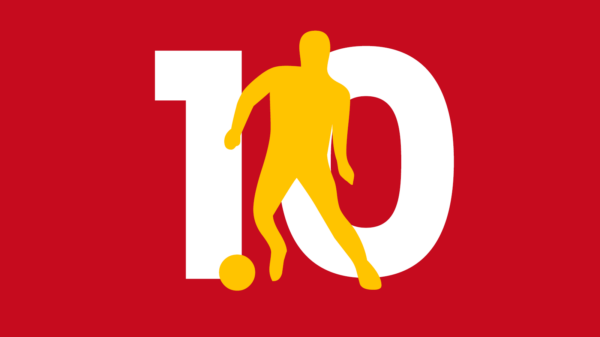With most fans wanting a happy medium between winning football and football that is pleasing on the eye, a sole focus on playing the long ball is almost non-existent in the modern game. However, when coupled with a more expansive approach, playing direct football has its benefits and shouldn’t be dismissed, says Patrick Mills.

Breaking the lines
When playing against a team that sits behind the ball and focuses on maintaining a compact defensive unit, using a target player has its benefits. Many teams will concede that they have inferior levels of playing ability to their opposition and so will see fit to ‘park the bus’. In a compact team, the gaps between each player will be small and so their opponents will find it difficult, not only to play penetrative passes between these gaps but will also struggle to find space to receive the ball between the defensive blocks, i.e between the defensive line and midfield line. One way in which the side in possession can break these lines, however, is by utilizing a target man.
As I have already mentioned, playing through narrow gaps with the ball on the ground will be difficult and so one alternative is achieved by playing lofted passes into the front line for a target player to knock down to ring-fencing midfielders. This is to say that when the lofted ball is played towards the target player, teammates will anticipate the destination of the knock down and move into the pocket of space to receive the ball, thus evading the opponent’s midfield screening block. Now that one of the two defensive lines has been escaped, the team in possession is in a position to either shoot or play through balls between the back line, who are now likely to be more disorganized. Particularly because the defenders will have been attracted to the ball during the initial lofted pass, leaving the surrounding space more open and unsettling the defence in general.
Variations of the target man
Although this method usually sees a tall striker playing the role of target man, there are also a couple of variations. For example, Bayern Munich coach Pep Guardiola has used this in the past as a way of bypassing the ‘Gegenpress’ of Jurgen Klopp’s Borussia Dortmund. Guardiola deployed Javi Martinez just in behind Dortmund’s midfield. This allowed Munich to play more direct instead of attempting to play through their opponent’s aggressive midfield pressure. Martinez would then lay it off to surrounding teammates or turn and spread the ball out wide.
A common sight in English football, defenders are also adept at playing this role. Their physical presence, coupled with their aerial ability makes them difficult for opposing defenders to play against. One famous example was when Sam Allardyce played Christopher Samba as a make-shift centre forward during their time at Blackburn Rovers. Samba had built a reputation for being a tough tackling defender while Allardyce had gained the tag of ‘long-ball specialist’. More recently, West Brom have used the technique from goal kicks.
Although playing direct from the kickoff isn’t uncommon, Tony Pulis does things slightly differently. Over the years, Pulis has tended to use centre-backs at full-back with two out and out wingers in front of them. From kickoffs, one of the fullbacks goes forward to compete for the long ball with the opposition’s corresponding full-back, thus attempting to get the ball forward more quickly and once again, bypassing the opponent’s midfield line.
Counter-attacks
The benefits of playing with a target player up front are also evident in counter-attacks. Often, a team’s counter-attacks will be built upon pacey wingers who can exploit the opposition’s defensive instability. However, there is also a place for physically imposing front men in counter-attacks. The best example of this is probably Atletico Madrid’s use of Mario Mandzukic last season. The Croat striker has since left to join Juventus but was a valuable asset during his time at the Vicente Calderon.
Diego Simeone prides himself on defensive organization combined with quick transitions into attack, and vice-versa. On a number of occasions last term, Atletico played quick and direct towards Mandzukic after turning over possession. The former Munich forward then used his strength to hold the ball up and allow his teammates time to get forward in support or else laid it off to support striker Antoine Griezmann.
Reference point
In modern times, the ‘target man’ is more commonly known as the reference point. For teams that play just one central striker, the likelihood is that the player in question is physically capable of holding the ball up as well as occupying at least two defenders. Such has been the emergence of the lone striker, diminutive goalpoachers have become somewhat obsolete at the top of the game. The role of the reference point is to provide a focal point of attacks for the wingers and midfielders to work off. A lot of the time, they must play with their back to goal and it could be argued that their value to the team is less goal-orientated than that of a striker in a two-pronged front line.
Good examples of attacking reference points include Olivier Giroud and Graziano Pelle at Arsenal and Southampton respectively. Both players regularly find themselves facing away from goal and making flick-ons or lay-offs to their surrounding teammates. Taking the Premier League as a suitable example, 15 of the 20 current top-flight teams play with one centre-forward more often than not. Of those 15 clubs, just two of the first choice options are under 6ft. Across the Premier League first team squads there are a total of 41 strikers over 6ft tall. Having a striker with these qualities allows a team to vary their play between patient build ups and going more direct. Managers clearly recognize the importance of having a reference point or target man. In fact, Manchester United are the only team in the Premier League not to have a 6ft something striker in their squad, and even they can be seen using Marouane Fellaini in this role on occasion.
Conclusion
Despite the stigma attached, even the most well respected managers in world football acknowledge the benefits of playing direct. Whether it be throwing a no-nonsense centre-back forward in search of an equaliser, playing over the opposition’s defensive lines rather than through them or catching the opponents out after a turnover in possession, the ‘long ball’ and the use of a target man certainly has its merits. It may not be as aesthetically pleasing as a thirty-something pass move from back to front but for the pragmatist, it’s an effective tool in winning football matches.
Written by Patrick Mills
- Tactical Philosophy: Patrick Vieira - September 29, 2017
- Scout Report: Phil Foden | Man City’s homegrown midfielder - August 28, 2017
- Scout Report: Jadon Sancho | Man City’s teenage sensation - August 28, 2017



























































